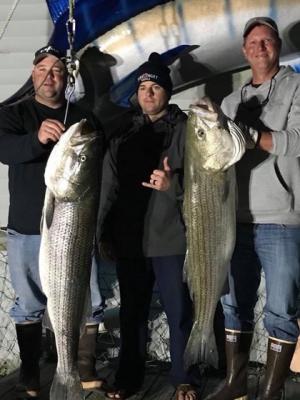While we await the movement of ocean-run rockfish from New Jersey to Delaware, Virginia anglers are catching big rock out of Cape Charles. This fishery has been going on for several years and shows no signs of slowing down.
I have no idea where these big rock come from. As noted, the main population of big rockfish remains in New Jersey, but this bunch shows up in the lower Chesapeake Bay every fall into early winter. While the rockfish season in the Virginia portion of the Chesapeake Bay closes Dec. 31, catch-and-release is legal, and the state will still honor applications for a release citation.
There is a launch ramp in Cape Charles, but they try to hide it. You have to go in town, turn left and cross the bridge over the railroad, travel a short distance, then turn right on the road that leads to the ramp. Signs are scarce, and I hope you have a GPS in your truck.
The primary technique for catching these fish is drifting with live eels. Most anglers will deploy three eels at different depths. One will be free swimming, one will be dropped to a depth halfway to the bottom and one will be right on the bottom.
The basic rigs are a fish-finder for the bottom eel, then a float for the one suspended halfway to the bottom and another float for the free-swimming eel. I rig an 8/0 circle hook on 6 feet of 50-pound High Seas mono line. The leader is attached to the running line with a black ball-bearing swivel. Eels have a tendency to spin, so the ball-bearing snap swivel will prevent this spinning from turning your running line into a twisted mess.
The area where these big rockfish hang out is no secret. As you run out of Cape Charles, you will see the fleet to your south. There may be a few large commercial ships at anchorage waiting for dock space in Baltimore. Most will be coalers.
Make sure you follow the channel markers that run out of Cape Charles. The shoal to your west has a few shallow spots that can ruin your day before it gets started.
Using your SONAR, look for the drop from 16 to 95 feet between the C-10 and C-8 buoys. This edge runs all the way down to the Kiptopeke Breakwater. For some reason, the best fishing is usually around the northern part of this edge. Just look for the fleet and then try to pick a good location to begin.
I don’t want to make this place sound too good. The rockfish are there, but it takes being in the right place at the right time to catch one. Some boats will do well, while others will be skunked. It all depends on the whimsy of the fishing gods.
Travel time from Lewes to Cape Charles is a little more than two hours. There are two tackle shops, Sea Hawk (410-957-0198) just before the Virginia state line in Maryland and Chris’ Tackle (757-331-3000) a couple of miles below Cape Charles. Both are on Route 13. I recommend buying your eels before you leave Delaware. While both of these shops sell eels, their winter hours are not going to coincide with a predawn launch. There are a couple of inexpensive motels close to Cape Charles that have more than enough parking for your boat trailer. I have stayed at the one next door to Chris’ and found it more than adequate.
As I have reported, the rockfish right now are off New Jersey, and while that may sound closer than Cape Charles, it really isn’t. By the time you take the ferry and then drive to whatever town you plan to fish from, you will have spent more than two hours. There are no tolls, and the launch ramp in Cape Charles is free. By the time you pay for the ferry and the parkway tolls, you can easily cover the extra cost of fuel to run down to Cape Charles.
Let’s hope we get a nice long run of rockfish along the Delaware coast, but if not, Cape Charles is a viable alternative.
Fishing report
The tog and sea bass fishing has been really good when conditions allow the boats to get out on the fish. The Del-Jersey-Land Reef is still producing keeper sea bass, but the culling process is getting longer to fill a quota.
Tog action is another culling process. There seem to be plenty of shorts from the Delaware Bay on out to the ocean. Try wrecks and reefs from the mid-bay on out to 100 feet or more in the ocean. Sand fleas and green crabs have been the best tog baits.

























































